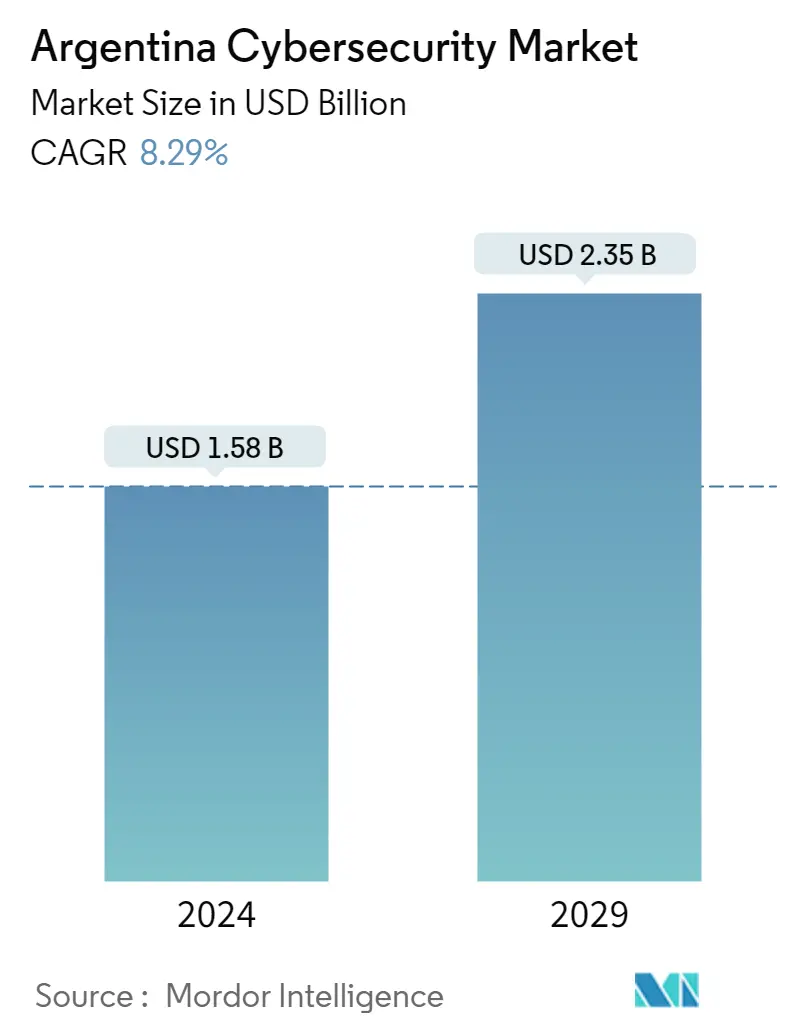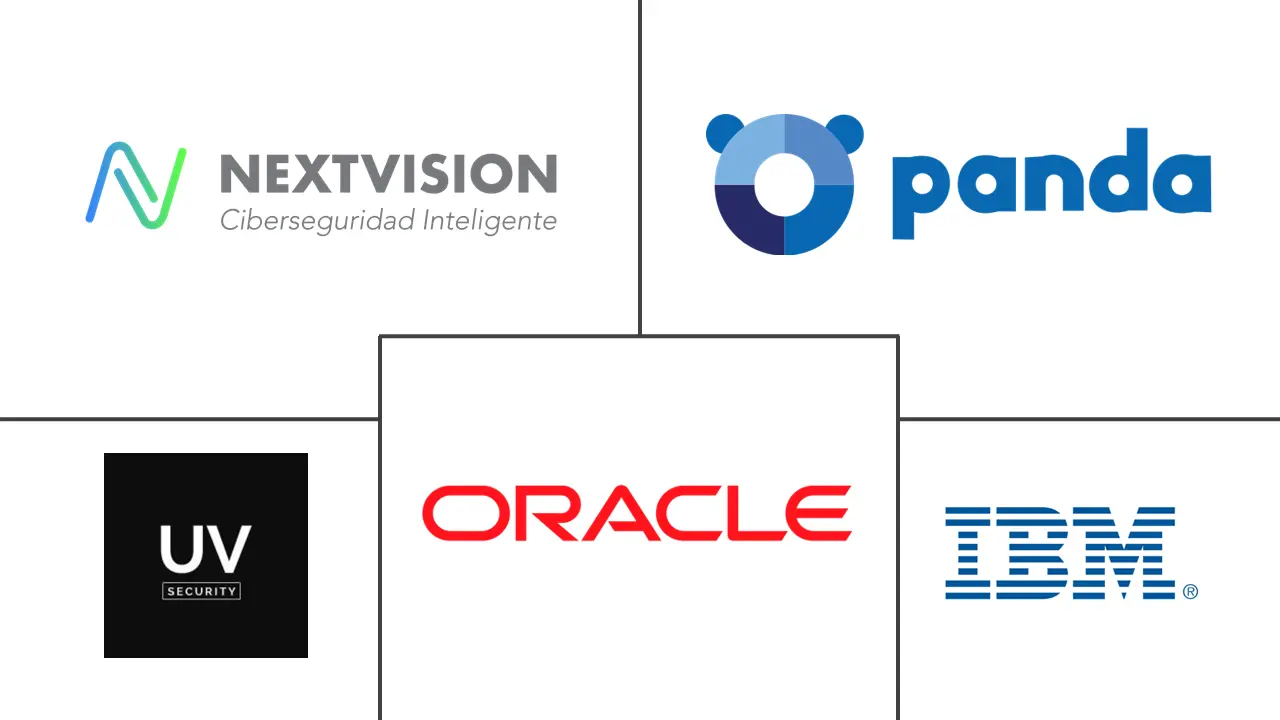Market Size of Argentina Cybersecurity Industry

| Study Period | 2019 - 2029 |
| Base Year For Estimation | 2023 |
| Market Size (2024) | USD 1.58 Billion |
| Market Size (2029) | USD 2.35 Billion |
| CAGR (2024 - 2029) | 8.29 % |
| Market Concentration | Medium |
Major Players
*Disclaimer: Major Players sorted in no particular order |
Argentina Cybersecurity Market Analysis
The Argentina Cybersecurity Market size is estimated at USD 1.58 billion in 2024, and is expected to reach USD 2.35 billion by 2029, growing at a CAGR of 8.29% during the forecast period (2024-2029).
The cybersecurity industry is gaining traction in this region due to the rising government initiatives increasing internet penetration across Argentina countries. Also, the expanding wireless network for mobile devices has increased data vulnerability making cybersecurity a crucial part of the organization. The rising cases of cyber attacks and regulations requiring reporting are driving the growth of the cybersecurity market in Argentina.
- Argentine society is significantly aware of cybersecurity issues. Still, it may be more focused on economic instability and physical security as this is more relevant to personal and family risk of cybersecurity threats. Cybersecurity technology adoption in Argentina is two to three years behind more mature markets such as the UK, US, or Brazil. Moreover, the exchange rate fluctuations and the devaluation of the Argentine peso negatively impacted the adoption of cybersecurity and related technologies.
- Guidelines for cybersecurity incident response and recovery were released by the Central Bank of Argentina (the "BCRA") on April 16, 2021, under Communication A7266. The BCRA specifically pointed out that the rules are intended for financial institutions, payment service providers that supply payment accounts, and the infrastructures of the financial markets. The BCRA emphasized that the rules, however, can be applied by any financial system institution as well as information technology and communication service providers, among others, due to their broad nature.
- To update and improve the data privacy framework, in January 2019, the Agency to Access to Public Information (the enforcement authority in charge of applying the Data Protection Law and the Do-Not-Call Law) issued Disposition 4/2019, which established a set of best practice guidelines for the interpretation and application of the Data Protection Law. The Disposition provides guiding criteria on (1) the right of access to personal data collected through closed-circuit television cameras, (2) automated data processing, (3) data dissociation, (4) biometric data, (5) consent, and (6) consent of minors.
- Financial and operational difficulties are anticipated to dominate the post-Covid period, which increased cyber threats in Argentina will also characterize. Regardless of their size, industry, or financial strength, all organizations are reassessing their budget and cybersecurity goals. There is a sense of shared urgency and a shift towards new models with integrated security, perimeter protection, automation, next-generation identity, and access restrictions. The culture of cyber resilience that exists today, where SMEs are bridging knowledge gaps, chief information security officers (CISOs) are raising awareness, and legislators are echoing cybersecurity concerns in political hallways, was discussed by experts as being the most crucial aspect.
- Insurers working to provide their customers with adequate cyber coverage must overcome a slew of challenges, such as the lack of historical data in case of an accident or loss due to natural calamity. In most cases, there is a lack of historical data, but the law also doesn't allow organizations to reveal cyber breaches other than those impacting consumer data. Therefore, a significant number of cyberattacks are left unreported. This deprives insurers of the data required to measure all the costs of cybercrime, making it difficult for them to derive effective cyber policies.
Argentina Cybersecurity Industry Segmentation
Cybersecurity solutions enable an organization to monitor, detect, report, and counter cyber threats that are internet-based attempts to damage or disrupt information systems and hack critical information using spyware, malware, and phishing to maintain data confidentiality.
The Argentina cybersecurity market is segmented by offering (security type (cloud security, data security, identity access management, network security, consumer security, and infrastructure protection) and services), deployment (cloud and on-premise), and end-user (BFSI, healthcare, manufacturing, government and defense, and IT and telecommunication). The market sizes and forecasts are provided in terms of value (USD million) for all the above segments.
| By Offering | |||||||||
| |||||||||
| Services |
| By Deployment | |
| Cloud | |
| On-premise |
| By End User | |
| BFSI | |
| Healthcare | |
| Manufacturing | |
| Government & Defense | |
| IT and Telecommunication | |
| Other End Users |
Argentina Cybersecurity Market Size Summary
The Argentina cybersecurity market is experiencing significant growth, driven by increased internet penetration and the expansion of wireless networks, which have heightened data vulnerability. This growth is further fueled by rising cyber attack incidents and regulatory requirements for reporting such breaches. Despite the growing awareness of cybersecurity issues, the adoption of advanced cybersecurity technologies in Argentina lags behind more mature markets like the US and UK. Economic factors, such as exchange rate fluctuations and the devaluation of the Argentine peso, have also posed challenges to the adoption of cybersecurity solutions. The Central Bank of Argentina and the Agency to Access Public Information have introduced guidelines and best practices to enhance data privacy and cybersecurity incident response, particularly in the financial sector.
The market is moderately consolidated, with major companies investing in strategic partnerships and product developments to expand their market share. Recent initiatives include the introduction of managed security service programs and partnerships aimed at supporting safe digital transformations. The convergence of operational and information technology has increased the vulnerability of industrial control systems, necessitating robust cybersecurity measures. As industries adopt digital technologies to improve efficiency, the need for comprehensive cybersecurity solutions becomes critical to protect against cyber threats. The market's growth is characterized by a shift towards integrated security models, automation, and advanced threat intelligence solutions, which are essential for mitigating risks and enhancing organizational security.
Argentina Cybersecurity Market Size - Table of Contents
-
1. MARKET INSIGHTS
-
1.1 Market Overview
-
1.2 Industry Value Chain Analysis
-
1.3 Industry Attractiveness - Porter's Five Forces Analysis
-
1.3.1 Threat of New Entrants
-
1.3.2 Bargaining Power of Buyers
-
1.3.3 Bargaining Power of Suppliers
-
1.3.4 Threat of Substitutes
-
1.3.5 Intensity of Competitive Rivalry
-
-
1.4 Impact of COVID-19 on the Market
-
-
2. MARKET SEGMENTATION
-
2.1 By Offering
-
2.1.1 Security Type
-
2.1.1.1 Cloud Security
-
2.1.1.2 Data Security
-
2.1.1.3 Identity Access Management
-
2.1.1.4 Network Security
-
2.1.1.5 Consumer Security
-
2.1.1.6 Infrastructure Protection
-
2.1.1.7 Other Types
-
-
2.1.2 Services
-
-
2.2 By Deployment
-
2.2.1 Cloud
-
2.2.2 On-premise
-
-
2.3 By End User
-
2.3.1 BFSI
-
2.3.2 Healthcare
-
2.3.3 Manufacturing
-
2.3.4 Government & Defense
-
2.3.5 IT and Telecommunication
-
2.3.6 Other End Users
-
-
Argentina Cybersecurity Market Size FAQs
How big is the Argentina Cybersecurity Market?
The Argentina Cybersecurity Market size is expected to reach USD 1.58 billion in 2024 and grow at a CAGR of 8.29% to reach USD 2.35 billion by 2029.
What is the current Argentina Cybersecurity Market size?
In 2024, the Argentina Cybersecurity Market size is expected to reach USD 1.58 billion.

